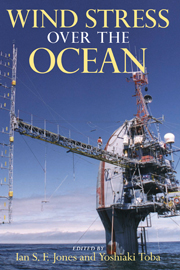Book contents
- Frontmatter
- Contents
- Preface
- Acknowledgements
- Contributors
- Frequently Used Symbols
- 1 Overview
- PART 1
- PART 2
- 8 The Influence of Swell on the Drag
- 9 The Influence of Unsteadiness
- 10 The Dependence on Wave Age
- 11 The Influence of Mesoscale Atmospheric Processes
- 12 Wind, Stress and Wave Directions
- 13 The Influence of Surface Tension
- 14 The Influence of Spatial Inhomogeneity: Fronts and Current Boundaries
- 15 Basin Boundaries
- References
- Index
14 - The Influence of Spatial Inhomogeneity: Fronts and Current Boundaries
Published online by Cambridge University Press: 16 October 2009
- Frontmatter
- Contents
- Preface
- Acknowledgements
- Contributors
- Frequently Used Symbols
- 1 Overview
- PART 1
- PART 2
- 8 The Influence of Swell on the Drag
- 9 The Influence of Unsteadiness
- 10 The Dependence on Wave Age
- 11 The Influence of Mesoscale Atmospheric Processes
- 12 Wind, Stress and Wave Directions
- 13 The Influence of Surface Tension
- 14 The Influence of Spatial Inhomogeneity: Fronts and Current Boundaries
- 15 Basin Boundaries
- References
- Index
Summary
Introduction
When an air mass blows over a sharp gradient in surface roughness and/or temperature, the air mass adjusts its turbulence structure to the new set of surface boundary conditions. Flow from a low roughness region to a downstream region of higher roughness produces a local increase in turbulence intensities and fluxes, exhibited by a sharp yet relatively small step function. The same pattern is found also for flow from a cold surface to a warmer surface, as occurs in the region of sea surface temperature fronts. Conversely, flow from a warm water surface to a colder one and/or from high roughness to low roughness, produces a drop in turbulence and fluxes. The drop in turbulence and flux levels is much larger than the increase in the first example. These changes in surface fluxes are more local in nature, i.e. generally covering scales of 10 km or less, and are caused by ocean currents, surface waves, and thermodynamic properties of the ocean associated with changes in depth, eddies, and overlying wind fields.
On the larger scale, the horizontal variability of surface fluxes and flux profiles must also be affected by variabilities due to processes within the atmosphere, e.g. transport and redistribution of flux with eddy scales, shear-induced gradients caused by moving storms, advection and circulation associated with sea breezes, and flow over sloping discontinuities associated with atmospheric fronts.
- Type
- Chapter
- Information
- Wind Stress over the Ocean , pp. 254 - 269Publisher: Cambridge University PressPrint publication year: 2001



